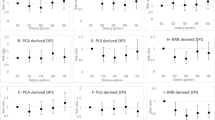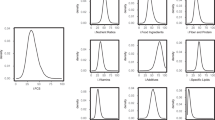Abstract
Background
With collection of repeated 24-hour recalls, there exist challenges in usual intake estimation, including infeasibility of multiple dietary assessments, and shortage of non-zero intakes for episodically consumed foods.
Objectives
We developed an ensemble method based on marginal-effect models (EMM), which estimates usual intake distribution using single-day data with internal or external two-day data.
Methods
The performance of the EMM was evaluated and compared with the National Cancer Institute (NCI) method and NCI 1-d method, via simulations with various scenarios and real data analyses of red meat, fish, and protein from Korea National Health and Nutrition Examination Survey (KNHANES).
Results
Simulations indicated the EMM (maximum bias of 1.67, 3.17, 8.57, 11.63 for average, median, 75%-tile, 95%-tile, respectively) provided more accurate estimation than the NCI method (maximum bias of 4.18, 9.43, 7.56, 37.43) across various scenarios on intake probability and within-person variation. The EMM showed robust estimation when an insufficient number of people have positive consumption on two days. In simulations with various external variance ratios, the EMM showed similar or superior performance to the NCI 1-d method. The EMM produced more stable estimates of usual intake distributions for red meat, fish, and protein than the two NCI methods.
Conclusion
The proposed EMM showed substantial improvement over the NCI methods when data contain a relatively small number of people with positive consumption on two days; is robust when food intake probability is very low or high; and estimates an external variance ratio with relatively low bias.
This is a preview of subscription content, access via your institution
Access options
Subscribe to this journal
Receive 12 print issues and online access
$259.00 per year
only $21.58 per issue
Buy this article
- Purchase on Springer Link
- Instant access to full article PDF
Prices may be subject to local taxes which are calculated during checkout




Similar content being viewed by others
Data availability
The 24-hour recall data and code book in KNHANES described in this manuscript are available upon request from the Korea Disease Control and Prevention Agency (KDCA) (https://knhanes.kdca.go.kr/knhanes/sub03/sub03_02_05.do). The analytic code for the EMM will not be available because it is in the patent application process, but we are open to collaborative research upon request.
References
Knekt P, Kumpulainen J, Järvinen R, Rissanen H, Heliövaara M, Reunanen A, et al. Flavonoid intake and risk of chronic diseases. Am J Clin Nutr. 2002;76:560–8.
Hung HC, Joshipura KJ, Jiang R, Hu FB, Hunter D, Smith-Warner SA, et al. Fruit and vegetable intake and risk of major chronic disease. J Natl Cancer Inst. 2004;96:1577–84.
Murphy SP, Poos MI. Dietary Reference Intakes: summary of applications in dietary assessment. Public Health Nutr. 2002;5:843–9.
United States, Dietary Guidelines Advisory Committee. Dietary guidelines for Americans, 2010. U.S. Department of Health and Human Services, U.S. Department of Agriculture, 2010. Internet: https://play.google.com/store/books/details?id=jbHTXAkN3HYC&rdid=book-jbHTXAkN3HYC&rdot=1 (accessed 19 July 2021).
Institute of Medicine (US) Subcommittee on Interpretation and Uses of Dietary Reference Intakes, Institute of Medicine (US) Standing Committee on the Scientific Evaluation of Dietary Reference Intakes. DRI Dietary Reference Intakes: Applications in Dietary Assessment. Washington (DC): National Academies Press (US), 2000. Internet: http://www.nap.edu/openbook.php?isbn=0309071836 (accessed 19 July 2021).
Palaniappan U, Cue RI, Payette H, Gray-Donald K. Implications of day-to-day variability on measurements of usual food and nutrient intakes. J Nutr. 2003;133:232–5.
Tooze JA, Midthune D, Dodd KW, Freedman LS, Krebs-Smith SM, Subar AF, et al. A new statistical method for estimating the usual intake of episodically consumed foods with application to their distribution. J Am Diet Assoc. 2006;106:1575–87.
Dodd KW, Guenther PM, Freedman LS, Subar AF, Kipnis V, Midthune D, et al. Statistical methods for estimating usual intake of nutrients and foods: a review of the theory. J Am Diet Assoc. 2006;106:1640–50.
Guenther PM, Kott PS, Carriquiry AL. Development of an approach for estimating usual nutrient intake distributions at the population level. J Nutr. 1997;127:1106–12.
Carriquiry AL. Estimation of usual intake distributions of nutrients and foods. J Nutr. 2003;133:601S–8S.
Nusser SM, Carriquiry AL, Dodd KW, Fuller WA. A semiparametric transformation approach to estimating usual daily intake distributions. J Am Stat Assoc. 1996;91:1440–9.
Hankin JH, Stram DO, Arakawa K, Park S, Low SH, Lee HP, et al. Singapore Chinese Health Study: development, validation, and calibration of the quantitative food frequency questionnaire. Nutr Cancer. 2001;39:187–95.
Johansson I, Hallmans G, Wikman A, Biessy C, Riboli E, Kaaks R. Validation and calibration of food-frequency questionnaire measurements in the Northern Sweden Health and Disease cohort. Public Health Nutr. 2002;5:487–96.
Araujo MC, Yokoo EM, Pereira RA. Validation and calibration of a semiquantitative food frequency questionnaire designed for adolescents. J Am Diet Assoc. 2010;110:1170–7.
Haubrock J, Nöthlings U, Volatier JL, Dekkers A, Ocké M, Harttig U, et al. European Food Consumption Validation Consortium. Estimating usual food intake distributions by using the multiple source method in the EPIC-Potsdam Calibration Study. J Nutr. 2011;141:914–20.
Nusser SM, Fuller WA, Guenther PM. Estimating usual dietary intake distributions: adjusting for measurement error and nonnormality in 24-hour food intake data. Center for Agricultural and Rural Development (CARD) Publications 95-sr80, Center for Agricultural and Rural Development (CARD) at Iowa State University, 1995.
Dekkers AL, Verkaik-Kloosterman J, van Rossum CT, Ocké MC. SPADE, a new statistical program to estimate habitual dietary intake from multiple food sources and dietary supplements. J Nutr. 2014;144:2083–91.
Luo H, Dodd KW, Arnold CD, Engle-Stone R. A new statistical method for estimating usual intakes of nearly-daily consumed foods and nutrients through use of only one 24-hour dietary recall. J Nutr. 2019;149:1667–73.
Laureano GH, Torman VB, Crispim SP, Dekkers AL, Camey SA. Comparison of the ISU, NCI, MSM, and SPADE methods for estimating usual intake: a simulation study of nutrients consumed daily. Nutrients. 2016;8:166.
Tooze JA, Kipnis V, Buckman DW, Carroll RJ, Freedman LS, Guenther PM, et al. A mixed-effects model approach for estimating the distribution of usual intake of nutrients: the NCI method. Stat Med. 2010;29:2857–68.
National Cancer Institute. Usual dietary intakes: the NCI method. Internet: https://epi.grants.cancer.gov/diet/usualintakes/method.html (accessed 19 July 2021).
Zeger SL, Liang KY, Albert PS. Models for longitudinal data: a generalized estimating equation approach. Biometrics. 1988;1049–60.
Overall JE, Tonidandel S. Robustness of generalized estimating equation (GEE) tests of significance against misspecification of the error structure model. Biometrical J: J Math Methods Biosci. 2004;46:203–13.
Carpenter M, Diawara N. A multivariate gamma distribution and its characterizations. Am J Math Manag Sci. 2007;27:499–507.
R Core Team. R: A language and environment for statistical computing. R Foundation for Statistical Computing, Vienna, Austria, 2019. Internet: https://www.R-project.org/ (accessed 19 July 2021).
SAS Institute. SAS 9.4 Statements: Reference. SAS Institute Cary, NC, 2013. Internet: https://www.sas.com/en_us/home.html (accessed 19 July 2021).
Kweon S, Kim Y, Jang MJ, Kim Y, Kim K, Choi S, et al. Data resource profile: the Korea National Health and Nutrition Examination Survey (KNHANES). Int J Epidemiol. 2014;43:69–77.
Davis KA, Gonzalez A, Loukine L, Qiao C, Sadeghpour A, Vigneault M, et al. Early experience analyzing dietary intake data from the Canadian Community Health Survey-Nutrition using the National Cancer Institute (NCI) Method. Nutrients. 2019;11:1908.
Korea Disease Control and Prevention Agency (KDCA) website. https://knhanes.kdca.go.kr/knhanes/main.do.
Kweon S. Use of secondary and tertiary food code in Korea National Health and Nutrition Examination Survey microdata. Public Health Wkly Rep., KCDC. 2012;5:158–64.
Bennett E, Peters SAE, Woodward M. Sex differences in macronutrient intake and adherence to dietary recommendations: findings from the UK Biobank. BMJ Open. 2018;8:e020017.
Hyndman RJ, Athanasopoulos G. Forecasting: principles and practice. OTexts, 2018.
Souverein OW, Dekkers AL, Geelen A, Haubrock J, de Vries JH, Ocké MC, et al. EFCOVAL Consortium. Comparing four methods to estimate usual intake distributions. Eur J Clin Nutr. 2011;65:S92–101.
Australian Bureau of Statistics. Catalogue No 4363.0. 55.001-Australian Health Survey: users’ guide, 2011–13, 2013.
Ethiopian Public Health Institute. Ethiopia national food consumption survey. Ethiopian Public Health Institute, Addis ababa, Ethiopia, 2013.
Rivera JA, Pedraza LS, Aburto TC, Batis C, Sánchez-Pimienta TG, González de Cosío T, et al. Overview of the dietary intakes of the Mexican population: results from the National Health and Nutrition Survey 2012. J Nutr. 2016;146:1851S–5S.
Hill RJ, Davies PS. The validity of self-reported energy intake as determined using the doubly labelled water technique. Br J Nutr. 2001;85:415–30.
Trabulsi J, Schoeller DA. Evaluation of dietary assessment instruments against doubly labeled water, a biomarker of habitual energy intake. Am J Physiol Endocrinol Metab. 2001;281:E891–9.
Macdiarmid J, Blundell J. Assessing dietary intake: Who, what and why of under-reporting. Nutr Res Rev. 1998;11:231–53.
Subar AF, Kipnis V, Troiano RP, Midthune D, Schoeller DA, Bingham S, et al. Using intake biomarkers to evaluate the extent of dietary misreporting in a large sample of adults: the OPEN study. Am J Epidemiol. 2003;158:1–13.
Krebs-Smith SM, Graubard BI, Kahle LL, Subar AF, Cleveland LE, Ballard-Barbash R. Low energy reporters vs others: a comparison of reported food intakes. Eur J Clin Nutr. 2000;54:281–7.
Basiotis PP, Welsh SO, Cronin FJ, Kelsay JL, Mertz W. Number of days of food intake records required to estimate individual and group nutrient intakes with defined confidence. J Nutr. 1987;117:1638–41.
Kim DW, Kyung Park M, Kim J, Oh K, Joung H, Lee JE, et al. Sources of variation in nutrient intake and the number of days to assess usual intake among men and women in the Seoul metropolitan area, Korea. Br J Nutr. 2013;110:2098–107.
Funding
This work was supported by the Research Program funded by the Korea Centers for Disease Control and Prevention (2019E340200). This research was supported by a grant (17162MFDS026) from Ministry of Food and Drug Safety in 2017.
Author information
Authors and Affiliations
Contributions
The author’s contributions were as follows. All authors contributed to the model design and interpretation of the data; KK and IKY designed the research; SAC conducted research, analyzed data, and wrote the paper; JEL, KK, and IKY obtained the funding; KK and IKY had primary responsibility for final content. All authors read and approved the final manuscript.
Corresponding authors
Ethics declarations
Ethics approval
This study was conducted in accordance with the Ethical Guidelines of Epidemiological Research. This study was exempt from the applications of these guidelines because anonymized data was only used in this study.
Competing interests
The authors declare no competing interests.
Additional information
Publisher’s note Springer Nature remains neutral with regard to jurisdictional claims in published maps and institutional affiliations.
Supplementary information
Rights and permissions
Springer Nature or its licensor (e.g. a society or other partner) holds exclusive rights to this article under a publishing agreement with the author(s) or other rightsholder(s); author self-archiving of the accepted manuscript version of this article is solely governed by the terms of such publishing agreement and applicable law.
About this article
Cite this article
Chi, S.A., Lee, H., Lee, J.E. et al. An ensemble method based on marginal-effect models (EMM) for estimating usual food intake from single-day dietary data and internal/external two-day dietary data. Eur J Clin Nutr 77, 325–334 (2023). https://doi.org/10.1038/s41430-022-01231-1
Received:
Revised:
Accepted:
Published:
Issue Date:
DOI: https://doi.org/10.1038/s41430-022-01231-1



